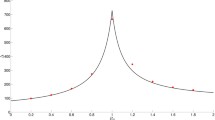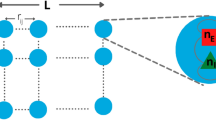Abstract
The power-law exponents of observed size and lifetime distributions of near-critical neural avalanches are calculated from neural field theory using diagrammatic methods. This brings neural avalanches within the ambit of neural field theory, which has also previously explained near-critical 1/f spectra and many other observed features of neural activity. This strengthens the case for near-criticality of the brain and opens the way for these other phenomena to be interrelated with avalanches and their dynamics.


Similar content being viewed by others
References
Abeysuriya RG, Rennie CJ, Robinson PA (2015) Real-time automated tracking of brain states using neural field theory. J Neurosci Meth 253:55
Allegrini P, Paradisi P, Menicucci D, Gemignani A (2010) Fractal complexity in spontaneous EEG metastable-state transitions: New vistas on integrated neural dynamics. Front. Physiol. 1:128
Bak P, Tang C, Wiesenfeld K (1987) Self-organized criticality: An explanation for \(1/f\) noise. Phys Rev Lett 59:381
Beggs JM, Plenz D (2003) Neural avalanches in neocortical circuits. J Neurosci 23:11167
Beggs JM, Plenz D (2004) Neuronal avalanches are diverse and precise activity patterns that are stable for many hours in cortical slice cultures. J Neurosci 24:5216
Brochini L, de Andrade Costa A, Abadi M, Roque AC, Stolfi J, Kinouchi O (2016) Phase transitions and self-organized criticality in networks of stochastic spiking neurons. Sci Rep 6:35831
Buszáki G, Mizuseki K (2014) The log-dynamic brain: How skewed distributions affect network operations. Nature Rev Neurosci 15:264
Coombes S, beim Graben P, Potthast R, Wright (eds) J (2014) Neural Fields: Theory and Applications, Springer, Berlin
Dahmen D, Grün S, Diesmann M, Helias M (2019) Second type of criticality in the brain uncovers rich multiple-neuron dynamics. Proc Nat Acad Sci USA 116:13051
De Dominicis C (1978) Dynamics as a substitute for replicas in systems with quenched random impurities. Phys Rev B 18:4913
Deco G, Jirsa VK (2012) Ongoing cortical activity at rest: Criticality, multistability, and ghost attractors. J Neurosci 32:3366
Deco G, Jirsa VK, Robinson PA, Breakspear M, Friston K (2008) The dynamic brain: From spiking neurons to neural masses and cortical fields. PLoS Comput Biol 4:e1000092
Deneve S, Machens CK (2016) Efficient codes and balanced networks. Nat Neurosci 19:375
di Santo S, Villegas P, Burioni R, Muñoz MA (2017) Simple unified view of branching process statistics: Random walks in balanced logarithmic potentials. Phys Rev E 95:032115
Fornito A, Zalesky A, Bullmore ET (2016) Fundamentals of brain network analysis. Elsevier, Amsterdam
Galán RF (2008) On how network architecture determines the dominant patterns of spontaneous neural activity. PLoS One 3:e2148
Gradshteyn IS, Ryzhik IM (1980) Table of integrals, series, and products. Academic Press, New York, p 678
Haimovici A, Tagliazucchi E, Balenzuela P, Chialvo DR (2013) Brain organization into resting state networks emerges at criticality on a model of the human connectome. Phys Rev Lett 110:178101
Harris TE (1989) The theory of branching processes. Dover, New York
Hinrichsen H (2000) Non-equilibrium critical phenomena and phase transitions into absorbing states. Adv Phys 49:815
Jirsa VK, Haken H (1996) Field theory of electromagnetic brain activity. Phys Rev Lett 77:960
Kerr CC, Rennie CJ, Robinson PA (2011) Model-based analysis and quantification of age trends in auditory evoked potentials. Clin Neurophysiol 122:134
MacLaurin JN, Robinson PA (2019) Determination of brain network connectivity from activity correlations. Phys Rev E 99:042404
Miller SR, Yu S, Plenz D (2019) The scale-invariant, temporal profile of neuronal avalanches in relation to cortical \(\gamma \)-oscillations. Sci Rep 9:16403
Nunez PL (1995) Neocortical dynamics and human EEG rhythms. Oxford, New York
O’Connor SC, Robinson PA (2004) Wavenumber power spectrum of the EEG, ECoG, and ERP. Neurocomput. 58–60:1181
Ódor G (2004) Universality classes in nonequilibrium lattice systems. Rev Mod Phys 76:663
Olver FWJ, Maximon LC (2010) In: NIST Handbook of Mathematical Functions, Olver FWJ, Lozier DW, Boisvert RF, Clark CW (eds) Cambridge University Press, Cambridge, pp. 248ff
Pernice V, Staude B, Cardanobile S, Rotter S (2011) How structure determines correlations in neuronal networks. PLoS Comput Biol 7:e1002059
Petermann T, Thiagarajan TC, Lebedev MA, Nicolelis MAL, Chialvo DR, Plenz D (2009) Spontaneous cortical activity in awake monkeys composed of neuronal avalanches. Proc Nat Acad Sci USA 106:15921
Plenz D (2012) Neural avalanches and coherence potentials. Eur Phys J Special Topics 205:259
Poil SS, Hardstone R, Mansvelder HD, Linkenkaer-Hansen K (2012) Critical-state dynamic of avalanches and oscillations jointly emerge from balanced excitation/inhibition in neuronal networks. J Neurosci 32:9817
Rennie CJ, Robinson PA, Wright JJ (2002) Unified neurophysical model of EEG spectra and evoked potentials. Biol Cybern 86:457
Robinson PA (2012) Interrelating anatomical, effective, and functional brain connectivity using propagators and neural field theory. Phys Rev E 85:011912
Robinson PA (2017) The balanced and introspective brain. Roy Soc Interface 14:20160994
Robinson PA (2019) Physical brain connectomics. Phys Rev E 99:012421
Robinson PA, Rennie CJ, Wright JJ (1997) Propagation and stability of waves of electrical activity in the cerebral cortex. Phys Rev E 56:826
Robinson PA, Rennie CJ, Rowe DL (2002) Dynamics of large-scale brain activity in normal arousal states and epileptic seizures. Phys Rev E 65:041924
Robinson PA, Sarkar S, Pandejee GM, Henderson JA (2014) Determination of effective brain connectivity from functional connectivity with application to resting state connectivities. Phys Rev E 90:012707
Salinas E, Sejnowski TJ (2000) Impact of correlated synaptic input on output firing rate and variability in simple neuronal models. J Neurosci 20:6193
Shriki O, Alstott J, Carver F, Holroyd T, Henson RNA, Smith ML, Coppola R, Bullmore E, Plenz D (2013) Neuronal avalanches in the resting MEG of the human brain. J Neurosci 33:7079
Sporns O (2011) Networks of the brain. MIT Press, Cambridge, MA
Tagliazucchi E, Balenzuela P, Fraiman D, Chialvo DR (2012) Criticality in large-scale brain fMRI dynamics unveiled by a novel point process analysis. Front Physiol 3:15
Touboul J, Ermentrout GB (2011) Finite-size and correlation-induced effects in mean-field dynamics. J Comput Neurosci 31:453
Yu S, Klaus A, Yang H, Plenz D (2014) Scale-invariant neuronal avalanche dynamics and the cut-off in size distributions. PLoS One 9:e99761
Zapperi S, Lauritsen KB, Stanley HE (1995) Self-organized branching processes: A mean-field theory for avalanches. Phys Rev Lett 75:4071
Author information
Authors and Affiliations
Corresponding author
Additional information
Communicated by Benjamin Lindner.
Publisher's Note
Springer Nature remains neutral with regard to jurisdictional claims in published maps and institutional affiliations.
I thank K. N. Mukta for useful discussions on evoked potentials. This work was supported by the Australian Research Council Center of Excellence Grant CE140100007 and the Australian Research Council Laureate Fellowship Grant FL1401000225.
Rights and permissions
About this article
Cite this article
Robinson, P.A. Neural field theory of neural avalanche exponents. Biol Cybern 115, 237–243 (2021). https://doi.org/10.1007/s00422-021-00875-9
Received:
Accepted:
Published:
Issue Date:
DOI: https://doi.org/10.1007/s00422-021-00875-9




